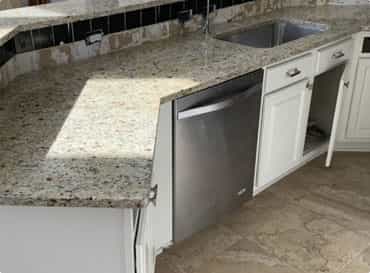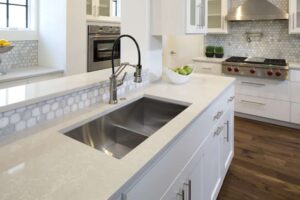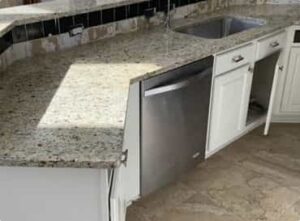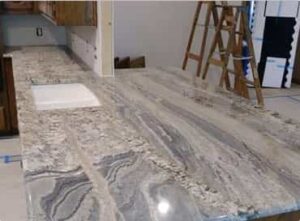Granite, like most natural stones, can be expensive. These tips can help save between 20-30 % off a professional installation by doing it yourself.
STEP 1: PLAN THE INSTALLATION
When planning your installation, working with your local stone fabrication shop is key. Granite is heavy, difficult to transport and must be cut with specialty tools. And though it’s known for its hardness, if it’s not handled correctly or installed with proper support, it can crack or, worse, break.
There are few fixes for a broken slab of granite. So it’s a good idea to work closely with your local stone fabricator.
The first step is to decide what type of granite you want. The shop will have many samples and slabs. You’ll see all the varied colors and grain patterns up close.
You’ll also see the various edging patterns to choose from: square, bevel, bull-nose, miter, ogee and many more.
You may want to have the fabricator visit your kitchen to check if anything there may affect how the countertops are made, such as wall bump-outs or exposed pipes.
In addition to the main countertop surface, you’ll need to decide on the length of the countertop overhang, as well as the type and size of backsplash.
STEP 2: MEASURE FOR INSTALLATION
Once you’ve got your granite picked out and your old countertops removed, take accurate measurements of your base cabinets to give to the fabricator. Start with the tops of the base cabinets, including the distance from the front of the face frame to the wall along the entire length of cabinets.
STEP 3: CREATE A TEMPLATE
The most accurate way to get measurements for your fabricator is to make a template from cardboard, thin luan plywood or even Mylar plastic.
Scribe the template so that it fits snugly against the wall along the entire run of cabinets before tracing the front edge onto the template.
In your template, you must measure the exact locations of cutouts for sinks and cooktops, and holes for faucets and soap dispensers. Be careful not to allow a span of more than 2 feet between cabinets, such as a span over a dishwasher. And allow no more than 6 inches of unsupported overhang with 2-centimeter stone and 9 inches with 3-centimeter stone.
If you plan an undermount sink, make note of that on the template for the fabricator, who will be able to cut a groove along the underside edge of the sink hole, so that the sink clips can be secured.
Also, insist that your fabricator “rod” the cutouts with steel or fiberglass reinforcements to strengthen the narrow areas around the cutouts.
Remember, if you’ll feel more comfortable, you can always negotiate an itemized price for your stone fabricator to come and take the measurements to ensure accuracy.
Once you’ve clearly specified your requirements and submitted your measurements, set a date for pickup or delivery of your finished countertops.
STEP 4: PREPARE FOR INSTALLATION
Check to make sure your base cabinets are level across their entire length. If not, unfasten the base units and level them with shims underneath the baseboard.
It’s not a good idea to use shims directly under the granite countertop. This will create small voids that could cause the granite to crack under pressure.
STEP 5: TRANSPORTING GRANITE
Now that you’ve given measurements to the fabricator and leveled your cabinets, it’s time to get the cut countertops home safely, which can be tricky.
Unless they’re being delivered, you’ll have to pick up the countertops from the fabricator when they’re ready.
Remember that granite is heavy — a 2′ x 6′ countertop can weigh in excess of 400 pounds — so enlist some help to transport and move the countertops safely.
It’s important to always carry the countertops in a vertical position, never horizontally flat, to avoid cracking or breaking the stone. To transport granite slabs, carry them on edge in an A-frame rack, the way glass is carried. If needed, you can make a simple rack from 2x4s. Protect the edges by covering them with wide painter’s tape.
When the slabs arrive, have a cleared space ready in the kitchen area to store them upright on edge until you’re ready to install them.
STEP 6: INSTALL THE SLABS
Once you have the granite slabs home, it’s time to install them. First, dry-fit the countertop to ensure an accurate fit.
When lifting the countertop, take extra care to support the granite where it is thin, such as along cutouts.
Lay the slabs directly on the frames of the lower cabinets. It’s not necessary for the granite to be supported by an additional subsurface, like solid plywood.
If the wall-facing edge of a countertop isn’t flush and requires adjustment, carefully mark all the areas of the countertop to be removed and gently lower it back down.
Then, using a dry-cut diamond blade installed on an electric grinder, carefully shave the edge to the desired level, remembering to always wear protective eye-wear to guard against dust and grit.
Then fit the slabs back in place making sure all the edges fit snuggly and securely, including the seams between slabs if you have more than one.
STEP 7: JOIN THE SEAMS
With the slabs flush and level on the cabinets, if you have multiple slabs, now is the time to fit them together.
First, tape the edges to protect them. Join the butt seams using color-matched two-part epoxy, which you can purchase from the fabricator shop.
Tighten the tightening screws until you feel resistance. Attach and turn on the auto pump — the tension created will ensure that the edges of the seams remain flush as the epoxy dries. A seam setter also ensures that the top edges of the seams remain flush with each other.
When the epoxy is dry, after about an hour, remove the setter. Then carefully shave away any excess epoxy using a single-edge razor held vertically. Don’t hold the razor at an angle or you may gouge the epoxy. And remember to use even strokes.
STEP 8: ATTACH TO THE CABINETS
Now that the seams of the slabs are joined, it’s time to secure the stone to the cabinets. The weight of the countertops themselves is nearly enough to hold the stone in place, but you’ll still want to run a bead of caulk along the underside perimeter of the counter, where the stone meets the cabinet top.
Don’t use silicone caulk; over time, silicone caulk could wick into the stone and cause staining. Stick with acrylic.
STEP 9: APPLY A SEALER
With your installation complete, finish by applying granite sealer to your countertops; this will protect the stone and prevent any deep staining. Simply wipe it on evenly with a clean, soft cloth, making sure to get full coverage. Let dry for 24 hours.
STEP 10: MAINTENANCE
Clean your new countertops using only granite and quartz cleaner, which you can purchase at most fabrications shops. This special cleaner will leave no residue and keep your granite countertops looking shiny and new.
Installing a granite countertop yourself is challenging, but the cost-savings and enhancement to your kitchen are well worth the effort.
Source: DIY Network
View Original Post







